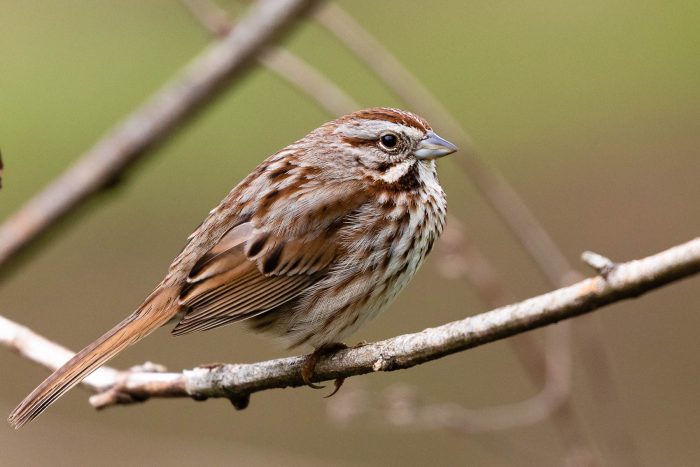Song Sparrow
Melospiza melodia
The song sparrow is a reddish-brown and gray bird that can be found in the Chesapeake year-round.
This section shows one large critter image at a time. Use the thumbnails that follow to select a specific image to display here.

This gallery contains a grid of small thumbnails. Selecting a thumbnail will change the main image in the preceding section.
Appearance
The appearance of the song sparrow can vary greatly in different locations. In the Chesapeake region, the song sparrow is a mix of reddish-brown, gray and white. The white chest is covered in reddish-brown streaks. It has a brown cap and a brown stripe that extends from the eye to the neck. It has a short bill with a long, rounded tail and broad wings.
Feeding
Song sparrows forage on the ground and will scratch the soil to find food.
Predators
Predators of song sparrows include raptors, snakes, raccoons, skunks and cats.
Flight
Song sparrows will fly quickly between areas of cover. They move their tail in a pumping motion while flying.
Voice
Song sparrows call two to three short notes followed by a trill.
Reproduction and life cycle
Song sparrow breed in the spring. They build their nests on the ground or in shrubs. Nests are rarely more than four feet above the ground. Females will incubate the eggs and both the male and female will care for the young when they hatch. Young leave the nest within two weeks of hatching and will remain with their parents for another three weeks. Song sparrows can raise multiple broods each year.
Did you know?
- Song sparrows are one of the most regionally variable birds in North America with 24 identified subspecies. Birds in northern territories tend to be darker than southern birds and birds in Alaska can weigh twice as much as other song sparrows.
- Male songbirds use their song to attract mates and to defend their territory. Each male will have several unique songs and will sing multiple songs in a varied sequence.
- Female song sparrows are more attracted to mates that sing more complex songs.
Sources and additional information
- All About Birds: Song Sparrow – The Cornell Lab of Ornithology
- Song Sparrow - Audubon Society
- Environmental Conservation Online System: Song Sparrow - U.S. Fish & Wildlife Service
